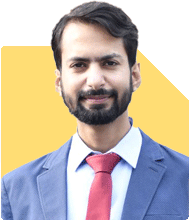Neeraj Batra | Answer |Ask -Follow
CA, CS, Commerce Expert - Answered on May 27, 2023
He has been teaching mathematics to CA, CS and commerce aspirants for over 11 years.
He has taught accounts and finance to IRS officers at the National Academy of Direct Taxes for three years and conducted numerous seminars at schools, colleges and MBA institutes in India.
Under his mentorship, several students have topped the competitive exam and secured All India Ranks.
Batra topped CA Intermediate (PCC) exam from Nagpur in 2009 and completed his CA and CS at the age of 21.
He has also cleared CFA (USA) Level 1.... more

My age is 23 didn't clear a single group of ca inter and so what to do? Please guide ...
Radheshyam Zanwar |5846 Answers |Ask -Follow
MHT-CET, IIT-JEE, NEET-UG Expert - Answered on Jul 26, 2025
Radheshyam Zanwar |5846 Answers |Ask -Follow
MHT-CET, IIT-JEE, NEET-UG Expert - Answered on Jul 26, 2025
Radheshyam Zanwar |5846 Answers |Ask -Follow
MHT-CET, IIT-JEE, NEET-UG Expert - Answered on Jul 26, 2025
Radheshyam Zanwar |5846 Answers |Ask -Follow
MHT-CET, IIT-JEE, NEET-UG Expert - Answered on Jul 26, 2025
Radheshyam Zanwar |5846 Answers |Ask -Follow
MHT-CET, IIT-JEE, NEET-UG Expert - Answered on Jul 26, 2025
Radheshyam Zanwar |5846 Answers |Ask -Follow
MHT-CET, IIT-JEE, NEET-UG Expert - Answered on Jul 26, 2025
Radheshyam Zanwar |5846 Answers |Ask -Follow
MHT-CET, IIT-JEE, NEET-UG Expert - Answered on Jul 26, 2025
Radheshyam Zanwar |5846 Answers |Ask -Follow
MHT-CET, IIT-JEE, NEET-UG Expert - Answered on Jul 26, 2025
Radheshyam Zanwar |5846 Answers |Ask -Follow
MHT-CET, IIT-JEE, NEET-UG Expert - Answered on Jul 26, 2025
Radheshyam Zanwar |5846 Answers |Ask -Follow
MHT-CET, IIT-JEE, NEET-UG Expert - Answered on Jul 26, 2025


















